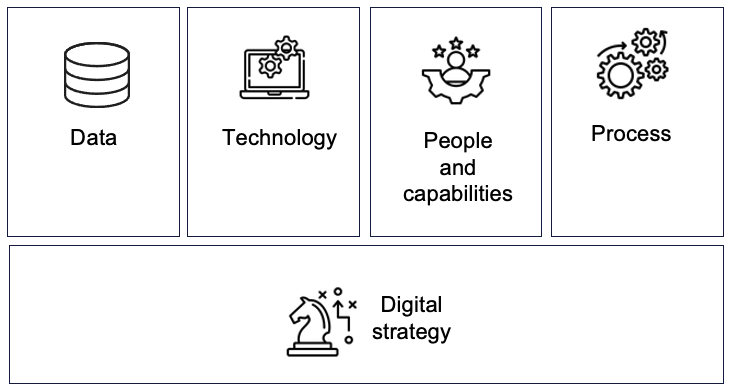I am often asked by companies, people and universities “How organisations can use artificial intelligence (AI) for their competitive advantage?”. In this article I’d like to share the framework that simplifies this complex question into 5 dimensions.
It’s no surprise in this day and age that organisations need to leverage AI to keep up with competition and ever increasing. Companies see real improvements from applying AI in their businesses. McKinsey estimates, that AI leaders show over 2 time better financial performance, 5-10% increase of revenue and 10-20% reduced cost [1].
This framework has 5 pillars that every organisation needs to adopt to realise value of artificial intelligence: strategy, data, technology, people and process. Let me go through each one of them, and provide an intuition with making a race car example.
Effective AI started to build a product based on this framework that allows companies to fast track their AI journey and become ultra competitive within months, instead of spending years building capabilities. Please reach out to me if you’re interested in participating in the trial of this product.

1. Digital strategy
The first and most important dimension is having a clear strategic vision, plan and roadmap for leveraging AI. Organisational leadership needs to determine how analytics can support key business objectives and priorities. This could include enhancing customer experience, optimising operations, gaining insights into new markets and more. Aligning analytics initiatives to strategic goals ensures efforts are focused and value is maximised.
In the race car example, strategy is the map and the route or routes that you planning to take.
2. Utilising high-quality data
High-quality, relevant data is the lifeblood for any AI initiative. Organisations must establish processes to capture both internal and external data from diverse sources. Ensuring data is cleansed, integrated and governed properly sets the foundation for powerful insights. Investments may also be required to fill data gaps through alternative sources. With a robust data strategy and architecture, organisations can fuel analytics programs for years. The recent advances in AI show that no matter how good your algorithm and hardware is, it’s the data that is the main driver of progress
In our race car example, data is fuel for the car.
3. Technology
Technology is a critical component in these 5 dimensions. In our road trip analogy, it’s a car itself. It includes decisions on infrastructure, architecture, hardware and software and platforms.
Building a robust analytics architecture is critical to enable AI competitive advantage. Depending on the organisation and its goals they can choose on-premise and/or cloud-based infrastructure. Organisations need also to design modern architectures and platforms to help them to reach their goals.
Finally, having the right software tools and libraries enable people to develop the use cases. Languages, with strong analytics support, like Python or R, allow data exploration while tools like PowerBI and Tableau enable visualization. Machine learning libraries like Scikit-learn, TensorFlow power predictive modelling. Natural language processing libraries help with text and language data. Proper model management systems govern deployed algorithms.
4. People and multidisciplinary teams
While technology is critical, people remain the most important asset for making AI a competitive advantage. Organisations need multidisciplinary teams including data scientists, data engineers, machine learning engineers, business analysts and experts to help build models, collaborate with business and ensure value delivery. Training existing staff and strategic hiring allows building these specialised analytical skills over time. Nurturing a culture of experimentation and innovation further unleashes the potential of people.
People - is a car driver. The car will not move or will not get to the end point if the driver doesn’t have relevant skills.
5. Process
Well defined processes in the company make the results of AI efforts optimal, effective, repeatable, scalable and allows for continuous improvement.
A version of Agile methodology allows analytical teams to work iteratively and deliver value every sprint via minimum viable products. Classic agile methodology can also be scaled across multiple levels of the company via frameworks like SAFe.
Additionally, there should be sufficient software engineering best practices, product development best practices, UI/UX and security processes in place to build a robust, scalable and extensible products.
Finally, organisations need a way to measure the results on regular basis to help pivot and understand if the products are going in the right directions.
While well-defined processes provide numerous benefits, organisations need to be cognizant of not going overboard and remain lean.
Conculsion
A holistic set of capabilities across these 5 dimensions allows organisations to maximise competitive advantage with artificial intelligence. With the right strategy, data, technology, skills and processes in place, AI becomes a strategic weapon to outperform competition.
Effective AI started to build a product based on this framework that allows companies to fast track their AI journey and become ultra competitive within months, instead of spending years building capabilities. Please reach out to me if you’re interested in participating in the trial of this product.
References:
[1] McKinsey Tech Trends Outlook 2022 link
This article reflects my personal views and opinions only, which may be different from the companies and employers that I am associated with.
